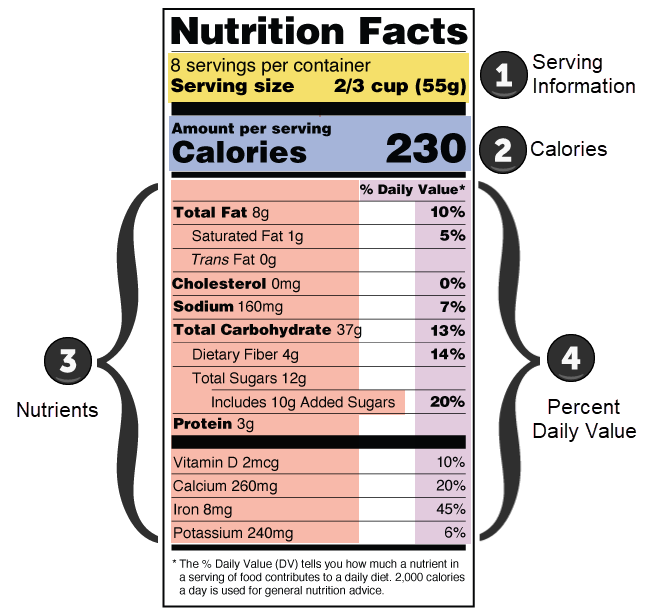
How to Read a Nutrition Facts Label
July 24, 2025 - Aditya Gupta, Amy Shovels, Michigan State University Extension

Whether you are grocery shopping for a family or choosing a snack on the go, being able to read and understand the Nutrition Facts Label on packaged goods is an important step towards making healthier choices.
Mandated by the U.S. Food and Drug Administration (FDA) and the U.S. Department of Agriculture (USDA), the Nutrition Facts Label is designed to help consumers understand what’s inside a product before purchasing or consuming it. In this way, you can make informed decisions that align with your dietary needs and goals.
The Nutrition Facts Label, most recently updated in 2016, is divided into four sections. Each section provides specific information about the food in the package.
Serving Information
Located at the top of the label, this section includes the servings per container, which is the total number of servings in the package, and the serving size, or the amount determined by the food manufacturer as a single serving. The serving size is designated by a common household measurement such as cup, tablespoon, piece or pouch, followed by the quantity in metric amounts, such as milliliters (mL) or grams (g).
It is important to note that the serving size reflects the amount typically consumed of that product and is not a recommendation for how much should be consumed.
The serving size can help you determine how many calories and nutrients you consume by eating the food. For example, if a box of cereal lists the serving size as 1 cup (about 40g), but you typically pour 2 cups into a bowl, you are consuming two servings. So, if one serving has 150 calories and 10g of sugar, your actual intake for two servings is 300 calories and 20g of sugar.
Calories
The Calories section contains the number of calories present in one serving of the product, as determined by the serving size in the section above. The number of calories per serving can help you determine how much of the food you might wish to eat, based on the total amount of calories recommended for you in a day.
While individual calorie needs vary, an intake of 2,000 calories per day serves as general nutrition advice for adults. To learn the daily calories recommended based on your age, sex, height, weight and physical activity level, use the MyPlate Plan calculator.
As an example of how the Calories section of the Nutrition Facts Label can provide context, imagine that a single-serving snack muffin contains 400 calories. Knowing that the general nutrition guide is based on a 2,000-calorie daily intake, this muffin would make up about 20% of that amount.
Nutrients
This section must list the amounts of the following nutrients that are present in one serving of the food in the package:
- Fats: Total fat, Saturated fat, Trans fat
- Cholesterol and Sodium
- Carbohydrates: Total Carbs, Dietary Fiber, Total Sugars, Added Sugars
- Protein
- Micronutrients: Vitamin D, Calcium, Iron, Potassium
Knowing these amounts can help you monitor nutrients that you should consume in higher or lower amounts to maintain a healthy lifestyle. As recommended by the Dietary Guidelines for Americans, nutrients to get more of include dietary fiber, vitamin D, calcium, iron and potassium. Nutrients to get less of include saturated fat, sodium and added sugars.
For example, if Bread A contains 1g of dietary fiber per serving and Bread B contains 5g of dietary fiber per serving, you might choose Bread B as the better source of dietary fiber.
Percent Daily Value
Present alongside the nutrients in the Nutrients section of the food label, the Percent Daily Value (% DV) signifies how much of a nutrient in one serving of the food contributes to a total daily diet or Daily Value. Daily Values are reference amounts of nutrients to consume or not to exceed daily.
The %DV helps determine if a serving is high or low in a particular nutrient.
- 5% DV or less of a nutrient in one serving is considered low.
- 20% DV or more of a nutrient in one serving is considered high.
For example, if a single serving of Soup A contains 230 mg of sodium, which is 10% DV and a single serving of Soup B has 60 mg of sodium, or 3% DV, you might choose Soup B if you are trying to limit your sodium intake.
Learning to read and understand the Nutrition Facts Label is a valuable tool in developing healthy eating habits. By using all four sections: Serving Information, Calories, Nutrients and Percent Daily Value, you can make decisions that better support your health goals. Making informed food choices does not have to be complicated, thanks to the information available on food labels.



 Print
Print Email
Email





